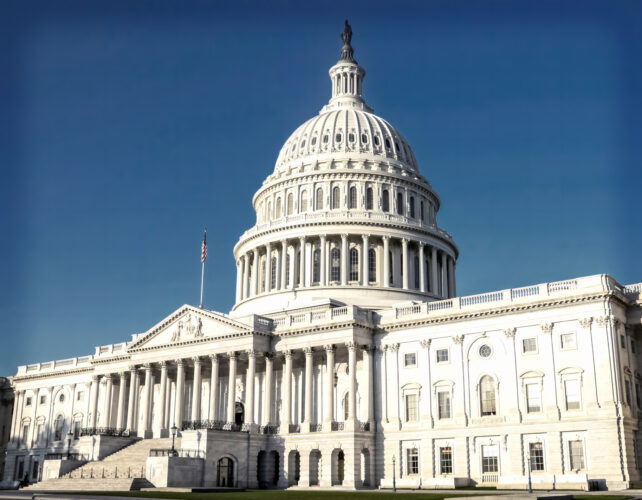Every few years, Congress discusses some form of spending limits. Usually, these go nowhere or are ignored or repealed a couple of years or so after passage.
There is a similar rule for federal tax revenues. Unlike the spending rule, the revenue rule is always in effect. Regardless of what Congress and the president may choose to do, this rule cannot be repealed.
This rule does not rely on Congress, the president, judges, the voters, or even the Constitution. As I note in my new Heartland Institute Policy Brief, “Federal Budget Deficits and the Iron Law of Federal Revenue,” history shows that annual federal government tax revenue since the end of World War II has continually hovered around 17.4 percent of U.S. gross domestic product, regardless of where the government sets the tax rates and what it chooses to tax. (See chart here.)
This is a fixed situation, not just a long-term average. The deviation from 17.4 percent at any point in time is only a percentage point or two. This means government cannot expect to get 35 percent of GDP for even a quarter of a year, much less a year or multiple years, no matter what tax rates are charged and how many different taxes are levied.
The Treasury might get as much as 18.5 percent of GDP for a few months, but revenue will gravitate back toward 17.4 percent of GDP very soon – and it will probably drop below that number for a while once the higher tax rates ripple through the economy and people alter their behavior to favor lower-taxed activities.
The U.S. government has tried multiple options over the decades, and the outcome has always been the same. In the 1950s and early 1960s, the top income tax rate was 91 percent, and estates could be taxed at 77 percent. The average tax take as a percent of GDP was 16 percent.
The limit applied even on the upper end: “the top 1 percent of taxpayers paid an average effective rate of only 16.9 percent in income taxes during the 1950s,” economist Scott Greenberg noted in a 2017 article for the Tax Foundation.
In 1964, the United States Revenue Act cut the top income tax rate from 91 percent to 70 percent, reduced the lowest rate from 20 percent to 14 percent, and lowered the corporate tax rate from 52 percent to 48 percent. The economy boomed, and unemployment dropped from 5.2 percent in 1964 to 3.8 percent in 1966.
Inflation-adjusted federal tax revenues increased in 1965, with the lower tax rates, after having fallen in 1964 with the much-higher rates. In nominal dollars, revenues rose by 28 percent from the second quarter of 1964 to the fourth quarter of 1966.
That happened because the pie from which the government was taking taxes got a lot bigger: inflation-adjusted GDP rose from $4.2 trillion in 1964 to nearly $4.8 trillion in 1966 – a 14 percent increase in just two years. GDP continued rising, reaching $5.3 trillion in 1969.
The same thing happened when Congress and President Ronald Reagan cut the top income tax rate from 70 percent to 50 percent in 1981, indexed the tax brackets to inflation, and cut the capital gains tax from 28 percent to 20 percent. Reagan and Congress then cut the top rate down to 28 percent in 1986, in legislation marred, unfortunately, by an increase in the capital gains rate back to 28 percent.
The U.S. economy boomed after the Reagan tax cuts took effect, and government tax revenues increased from $394 billion in 1981 to $601 billion in 1989. Similarly, after President Donald Trump signed the Tax Cuts and Jobs Act of 2017, federal tax revenues rose from almost $2 trillion in 2017 to $2.67 trillion in 2021.
As the data clearly show, tax revenues do not follow tax rates in the way politicians wish they would. Unless the government finds a way to force people to generate incomes (essentially enslaving the populace), raising the tax rate on any particular activity will reduce the amount of wealth generated by that activity that can be reported to authorities as income.
The real problem with the national budget is that the federal government has consistently been spending more than the maximum attainable percentage of GDP since 1967, a trend that worsened radically beginning with the Great Recession of 2007. Given that tax rates cannot raise revenues above the latter’s normal percentage of GDP for any appreciable length of time, the only way to reduce the budget deficit (and ever start paying off the federal debt) is to cut spending.
A government that ignores this fact ends up increasing tax rates repeatedly in a desperate attempt to pry more tax money out of the public than is possible. The only way to free a government from a deficit and debt trap is to cut spending and reduce tax rates.
The iron law of federal revenue means that a government that consistently overspends will run large and increasing deficits until it cuts spending. Period. Unless lawmakers and the American people accept the truth about the limits on federal revenue, we will continue to suffer from ever-increasing deficits and debt and all the economic ills they create.
S. T. Karnick (https://stkarnick.substack.com/) is a senior fellow at The Heartland Institute and author of the Life, Liberty, Property weekly e-newsletter.

